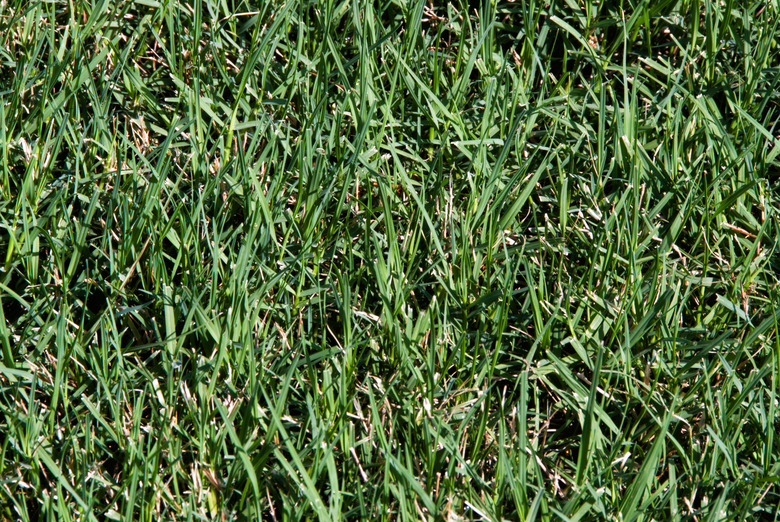How To Mix Bermudagrass With Fescue
We may receive a commission on purchases made from links.
A lush green lawn is not just a status symbol in a neighborhood; it provides a buffer to the street, a place for children to play and a restful oasis for the homeowner. Whether you live in a warm or cool climate, combining a warm-season grass, like bermudagrass (Cynodon dactylon), and a cool-season species, such as the fine fescues (Festuca spp.), gives you the best of summer, fall, winter and spring lawns. To mix bermudagrass with fescue, it's best to overseed the bermudagrass, hardy in U.S. Department of Agriculture plant hardiness zones 7 through 10, with a fine fescue blend, hardy in USDA zones 3 through 7.
Bermudagrass Versus Fescue
Bermudagrass Versus Fescue
Bermudagrass is a low-growing grass species that thrives in warm and hot weather. It stands up to heavy use and quickly fills in damaged areas due to its ability to spread via rhizomes and stolons. When cool weather arrives, bermudagrass goes dormant and turns yellow-brown.
The fine fescue species prefer cool temperatures and die back when the weather warms in spring. Mostly bunchgrasses, the fescues need a well-draining soil to produce a lush, dark-green, fine-leaved turf in sun or shade.
Mix Bermudagrass With Fescue
Mix Bermudagrass With Fescue
Mixing bermudagrass with fescue requires some preparation during the latter days of summer. Bermuda produces a dense turf, and its rapid growth may result in a thick layer of thatch. Use a dethatcher in midsummer to reduce thatch and aerate the lawn at least once before September to develop the seedbed needed when overseeding the fescue.
Wait to plant fescues until air temperatures are between 60 and 75 degrees Fahrenheit and soil temperatures are 50 to 65 degrees. Mow the bermudagrass and bag the clippings before spreading the fescue seed mix on the lawn. Fine fescue blends may include other cool-season grasses and fertilizer, eliminating the need to apply a separate starter fertilizer before sowing the seeds. Check the label to ensure that the weed seed levels are less than 0.25 percent.
Overseed with the fescue blend by spreading the seeds over the bermudagrass using a rotary or drop spreader. Apply the seed at one-half the rate needed for seeding a new lawn. Water thoroughly and then lightly moisten the lawn once or twice daily until the seeds germinate. While not completely necessary, topdressing the bermudagrass and fescue seeds with a thin layer of sand mixed with compost provides a smooth, nutrient-rich environment for the fescue seeds.
Care and Fertilizing of the Lawn
Care and Fertilizing of the Lawn
As the fescue germinates and grows, ease off on the watering until you've returned to a once- or twice-weekly application of 1 to 2 inches of water. Avoid heavy use of the lawn so the grass seedlings can become established. Remove weeds as they appear.
Allow the grass to grow to 4 to 4 1/2 inches tall and then mow to a 3-inch height. Leave the clippings on the lawn to decompose and return their nutrients to the soil. In general, fescues don't need a lot of fertilizer. If your soil is very poor or the fescue blend begins to turn a pale green, spray the lawn lightly with a 10-10-10 or 20-20-20 water-soluble fertilizer every four to six weeks. Do not use a slow-release fertilizer, and stop fertilizing in February.
In early spring when the weather warms, mow the lawn approximately 1 inch tall to shock the fescue and provide sunlight to the bermudagrass as it emerges from its winter dormancy. After the initial mowing, allow the bermudagrass to grow up to 2 inches tall and then resume mowing at the recommended height depending on the cultivar. Avoid removing more than one-third of the grass blades. If the grass gets too tall, set the mower to remove one-third of its height. Wait a few days and then mow again.
